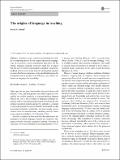Files in this item
The origins of language in teaching
Item metadata
| dc.contributor.author | Laland, Kevin N. | |
| dc.date.accessioned | 2016-07-15T13:30:03Z | |
| dc.date.available | 2016-07-15T13:30:03Z | |
| dc.date.issued | 2017-02 | |
| dc.identifier | 244334539 | |
| dc.identifier | c150dea1-773b-4f22-b24b-bfe3504124f4 | |
| dc.identifier | 84976501391 | |
| dc.identifier | 000395057300035 | |
| dc.identifier.citation | Laland , K N 2017 , ' The origins of language in teaching ' , Psychonomic Bulletin & Review , vol. 24 , no. 1 , pp. 225-231 . https://doi.org/10.3758/s13423-016-1077-7 | en |
| dc.identifier.issn | 1069-9384 | |
| dc.identifier.other | ORCID: /0000-0002-2457-0900/work/60630332 | |
| dc.identifier.uri | https://hdl.handle.net/10023/9148 | |
| dc.description | Research supported in part by a grant from the John Templeton Foundation. | en |
| dc.description.abstract | I introduce seven criteria for determining the validity of competing theories for the original function of language. I go on to present a novel explanation that meets all the criteria: language originally evolved to teach kin. I suggest that the use of symbols subsequently generated evolutionary feedback at two levels, in the form of self-modified selection pressures that favored structures in the mind that functioned to manipulate and use symbols with efficiency, and cultural selection on languages for learnability. | |
| dc.format.extent | 7 | |
| dc.format.extent | 285303 | |
| dc.language.iso | eng | |
| dc.relation.ispartof | Psychonomic Bulletin & Review | en |
| dc.subject | Evolution | en |
| dc.subject | Language | en |
| dc.subject | Teaching | en |
| dc.subject | BF Psychology | en |
| dc.subject | Experimental and Cognitive Psychology | en |
| dc.subject | Arts and Humanities (miscellaneous) | en |
| dc.subject | Developmental and Educational Psychology | en |
| dc.subject | T-NDAS | en |
| dc.subject.lcc | BF | en |
| dc.title | The origins of language in teaching | en |
| dc.type | Journal article | en |
| dc.contributor.sponsor | John Templeton Foundation | en |
| dc.contributor.institution | University of St Andrews. School of Biology | en |
| dc.contributor.institution | University of St Andrews. Scottish Oceans Institute | en |
| dc.contributor.institution | University of St Andrews. Institute of Behavioural and Neural Sciences | en |
| dc.contributor.institution | University of St Andrews. Centre for Social Learning & Cognitive Evolution | en |
| dc.contributor.institution | University of St Andrews. Centre for Biological Diversity | en |
| dc.identifier.doi | https://doi.org/10.3758/s13423-016-1077-7 | |
| dc.description.status | Peer reviewed | en |
| dc.identifier.grantnumber | 40128 | en |
This item appears in the following Collection(s)
Items in the St Andrews Research Repository are protected by copyright, with all rights reserved, unless otherwise indicated.

